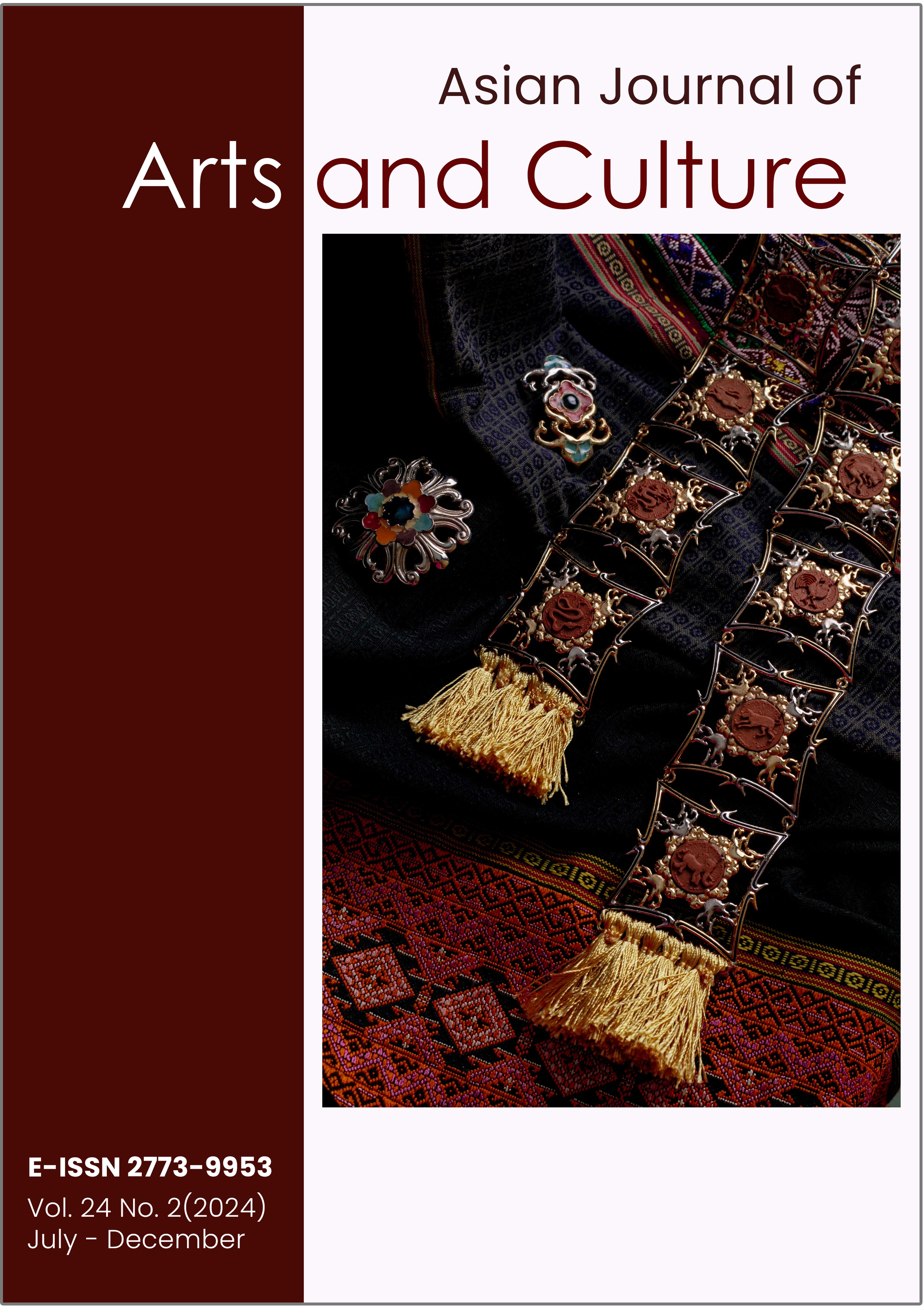Creation of Dance According to Beliefs from The Namo Coin Sign
Main Article Content
Abstract
The creative performance of the Pallava Namo series. The researcher used mixed methods by conducting qualitative research to find the form and elements of the performance and study the ideas obtained after the creation of a performance of a dance performance based on beliefs from the Namo coin symbol by using research tools consisting of studying and surveying information from academic documents, information media, studying areas and surveying field data, structured interviews and the researcher's experience used the obtained data to analyze and synthesize the content analysis and data triangulate. Then, evaluate the performance by using statistics and finding the mean and standard deviation and presenting them descriptively in the development and design of dance works that are used to explain through the dimensions of creative performing arts that are a medium for conveying values and importance.
The results showed that the creative styles can be classified according to 8 elements of the 1) Performance Design; is divided into 3 periods. The first period, “Pain” is the period that conveys pain and suffering and sadness from sickness and death from plague, the second period "Hope" is the period that conveys the prayers of the holy things and having hope. Based on the belief that sacred things will help protect and heal villagers from various illnesses, the third period, “Faith”, is a period that conveys a better life through belief and faith in Namo coins. 2) Selection of performers 3) Design of dance moves 4) Design of performance equipment 5) Performance Sound and music design, 6) costume design, 7) lighting design, and 8) performance space design. In addition, the researcher took into account three ideas obtained after creating dance: 1) considering creativity in dance, 2) considering the use of symbols in creating dance, and 3) considering dance theory, music, and visual arts.
Article Details

This work is licensed under a Creative Commons Attribution-NonCommercial-NoDerivatives 4.0 International License.
© 2018 by Asian Journal of Arts and Culture, Walailak University. All rights reserved.
References
Aneksuk, B. (2015). Development of tourism formats and products in Phitsanulok Province to support Thai tourists and tourists in ASEAN. complete research report.
Angwitthayathorn, C. (1995). Namo Coin Sign. Bangkok, Thaialnd: Darnsuthapress.
Chantamala, O. (2015). Some Tradition and Identities Reflected in Dancing Performances for Worshipping Religious Places in Northeast Thailand: Rabam Champasi. HuJmsU. 34(1), 232-237.
Chantanasaro, T. (2014). Dance from the trinity concept in Buddhism. Bangkok, Thaialnd: Chulalongkorn University.
Chanseng, J. (1999). Provincial seals in the southern region. Thailand Cultural Encyclopedia of Southern.
Charassri, N. (2007). Narai Avatara, Performing The Thai Ramayana in The modern world. Bangkok, Thaialnd: Amarin.
Cooper, S. (2016). Staging Dance. London, United Kingdom: A&C Black (Publishers) Limited.
Department of Cultural Promotion. (2017). Cultural Master Plan. Retrieved from https://www.egov.go.th/th/online.
Iamsakul, C. (2011). The art of choreographing (Creative Thai dance art). Bangkok, Thailand: Publishing House, A Copy Center.
Jirakanon, R. (2014). The art of designing modern theatrical costumes. Bangkok, Thailand: Chulalongkorn University.
Katekeaw, A., & Charassri, N. (2020). The Creation of a Dance from The Aum Symbol in Brahminism- Hinduism. Institute of Culture and Arts Journal, 21(2), 94-110.
Kosolhemani, J. (2013). Patterns and concepts in the creation of contemporary Thai dance. Works of Narapong Jarasri. Bangkok, Thailand: Chulalongkorn University.
Ministry of Culture. (2009). National Cultural Master Plan (2007-2016). Bangkok, Thailand: Office of Policy and Strategy.
Natayakul, S. (2006). Light and color arrangement in performing arts. Mahasarakham, Thailand: Mahasarakham University Publishing House.
Natayakul, S. (2022). The Creation of Dance. Mahasarakham, Thailannd: Mahasarakham University.
Nopudomphan, K. (2011). The Creation of Thai Contemporary Dance from Semiotics of Lotus in Buddhism. Bangkok, Thailand: Chulalongkorn University.
Nopudomphan, K. (2014). The Analytical Study on Designs of Costume for Dance Theses (Thai Dance) by Graduates of Srinakharinwirot University’s Faculty of Fine Arts, between 2003- 2007. Institute of Culture and Arts Journal, 16(1), 79-92.
Poonpakdee, N. (2019). The Creation of a Dance from Magic Tricks. Bangkok, Thailand: Chulalongkorn University.
Rittibul, P. (2015). Thai Dance: Convey of Cultural Rather Than Entertainment. Journal of Fine Arts Research and Applied Arts, 2(1), 106-137.
Rittibul, P. (2017). The Development of Thai Dance Performing from Cultural Capital to Be Existence in Thailand 4.0. Journal of Fine Arts Research and Applied Arts, 4(1), 225-249.
Rungthanapirom, T. (2017). The Theory of Beauty. Bangkok, Thailand: At Four Print.
Saitongkum, J. (2018). The Creative Process of Thai Dramatic Art-Sakkaratwarat Dance. Research and Development Journal Suan Sunandha Rajabhat University, 10(1), 103-117.
Sensai, P. (2003). Natyapradit. Mahasarakham, Thailand: Mahasarakham University.
Sukrakarn C. (2011). Currency used in Nakhon Si Thammarat. Nakhon Si Thammarat, Thailand: Nakhon Si Thammarat Rajabhat University.
Suwannasri, R. (2018). The Identities of Srivijaya Art for Products Design on Golden Niello Ware. Pathum Thani, Thailand: Faculty of Fine and Applied Arts, Rajamangala University of Technology Thanyaburi.
Thonburi, M. (1970). Namo Coin Sign Commemoration at the royal cremation ceremony. Khun Prajak Chalasin at the crematorium Chonprathanrangsarit, Monday, March 23, 1970. Nonthaburi, Thailand: Pakkred Women's Home.
Tunthong, K. (2020). The Study of Nhae Ane Lho Bong Rite Identity, Morgan Lifestyle, To Create The Project Through the Performance Aspect. Pathum Thani, Thailand: Rajamangala University of Technology Thanyaburi.
UNCTAD. (2008). Creative Economy Report 2008. United Nations. Retrieved from http://www.unctad.org/creative-economy.
Virulrak, S. (2004). Dance Arts Paritas. Bangkok, Thailand: Chulalongkorn University.
Wichasawat, P. (2020). Creative dance Nattaya Sattabut. The 2nd National Creative Work Presentation of Fine Arts: VRU Contemporary Folk Festival 2020, November 27, 2020. (pp.117-122). Faculty of Humanities & Social Sciences, Valaya Alongkorn Rajabhat University, Thailand.
Wimonkasem, K. (1999). Development of ancient script in Thailand. In society and culture in Thailand. Bangkok, Thailand: Princess Maha Chakri Sirindhorn Anthropology Centre.
Wisedsing, S. (2014). Flavor of Thai Dance Through the Modern Performance Narai Avatara. Institute of Culture and Arts Journal, 15(2), 135-140.
Wisutthiphan, T. (2021). Creative Dancing Art: Deity of Wealth. Nakhon Pathom, Thailand: Bunditpatanasilpa Institute.


